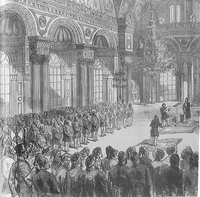Ottomanism
| History of the Ottoman Empire |
| Social structure |
|---|
| Court and aristocracy |
| Ethnoreligious communities |
| Rise of nationalism |
| Classes |

Ottomanism (Osmanlılık or Osmanlıcılık) was a concept which developed prior to the First Constitutional Era of the Ottoman Empire. Its proponents believed that it could solve the social issues that the empire was facing. Ottomanism was strongly influenced by thinkers such as Montesquieu and Rousseau and the French Revolution. It promoted equality among the millets. The idea originated amongst the Young Ottomans in areas such as the acceptance of all separate ethnicities in the Empire regardless of their religion, i.e. they were all 'Ottomans' with equal rights. Put simply, Ottomanism stated that all subjects were equal before the law. Ideally, all citizens would share a geographical area, a language, culture, and a sense of a 'non-Ottoman' party who were different than them. The essence of the millet system was not dismantled, but secular organizations and policies were applied. Primary education, conscription, head tax and military service were to be applied to non-Muslims and Muslims alike.[1]
The major precursors to Ottomanism were the Reformation Edict of 1856, which promised full equality regardless of religion, and the Ottoman Nationality Law of 1869, which created a common Ottoman citizenship irrespective of religious or ethnic affiliation. Ottomanism was rejected by many in the non-Muslim millets and by many Muslims. To the former, it was perceived as a step towards dismantling their traditional privileges. Meanwhile, the Muslims saw it as the elimination of their own superior position. There were claims that Ottomanism was a reaction to the Tanzimat, the era of intensive restructuring of the Ottoman Empire by the bureaucratic elite. The inauguration of the Ottoman Parliament contributed to the spirit of reform as all millets were represented in this bicameral assembly.
Ottomanism was a form of nationalism, likely inspired and created as a reaction to European ideas of nationalism and the growing Western involvement in the Ottoman Empire. Following the Tanzimat reforms, Ottomanism developed of of a need to bring the Empire together.[2] The Ottomans feared the growing threat the Europeans posed, especially after events like the Treaty of Balta Liman that allowed for British merchants in the Empire to be taxed equally to the locals, and the growing concern of the Great Powers over the treatment of Christians and Jews within the Empire. The Ottomans thought that if they could unite the Empire fully under one state entity, then they would be stronger and the Europeans would have a harder time encroaching on Ottoman territory, as well as Ottoman people. Previously, the empire was vastly split into many small communities that mostly governed themselves. The Sultan oversaw these communities, however most adhered to their own laws and beliefs.[3] This was a reason the Ancien Regime Ottoman Empire was so successful, because the Sultan didn't force any major changes on populations as he conquered them. Though because of nationalism, the rise of nation-states with shared senses of identities began to rise in Europe, most notably with the Greek War of Independence which also started effecting the Ottoman Empire. From these instances Ottomanism was developed as a social and political response, and a hope to help save the Empire from its downfall.
Ottomanism enjoyed a revival during the Young Turk Revolution of 1908, and during the Second Constitutional Era. It lost most of its adherents during the First Balkan War of 1912–13, when Ottoman citizens (Bulgarians, Greeks, Serbians) in the Balkans revolted against the government and enacted ethnic cleansing against Turks residing in those areas, leading to mass emigration of Turks to Anatolia. Disappointment in the failure of Ottomanism was integral to the birth of Turkish nationalism during the next decade.
See also
References
- ^ Dawn, C. Ernest. "From Ottomanism to Arabism: The Origin of an Ideology". The Reviews of Politics. 23.
- ^ Cleveland, William L. (2013). A History of the Modern Middle East. Westview Press. p. 265.
- ^ Kemal H. Karpat (2002). Studies on Ottoman Social and Political History: Selected Articles and Essays. BRILL. p. 207. ISBN 978-90-04-12101-0. Retrieved 11 February 2013.
- The concept is covered under the section The era of Modern Reform:Tanzimat at "History of the Ottoman Empire and Modern Turkey" by Stanford J. Shaw, Ezel Kural Shaw.
- Cleveland, William L. A History of the Modern Middle East. Boulder, CO: Westview, 2004. Print
